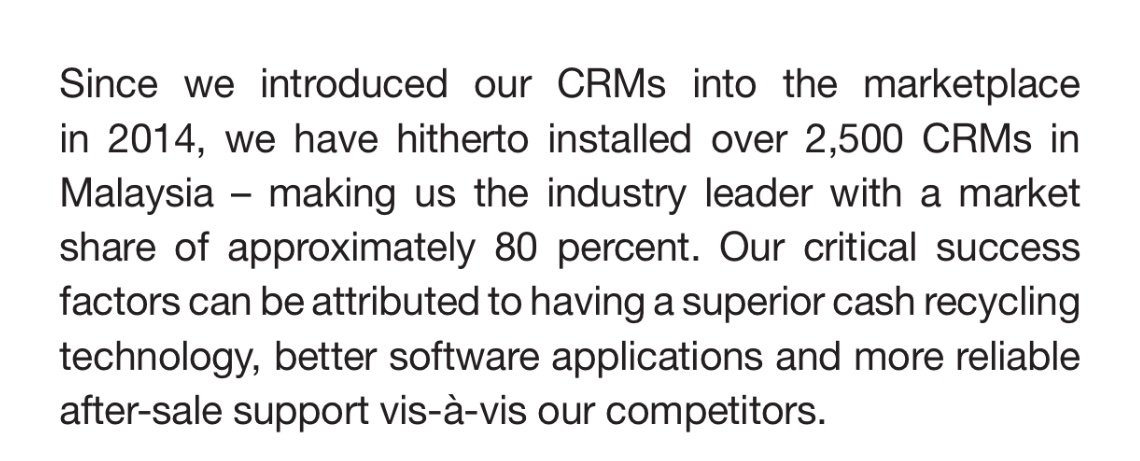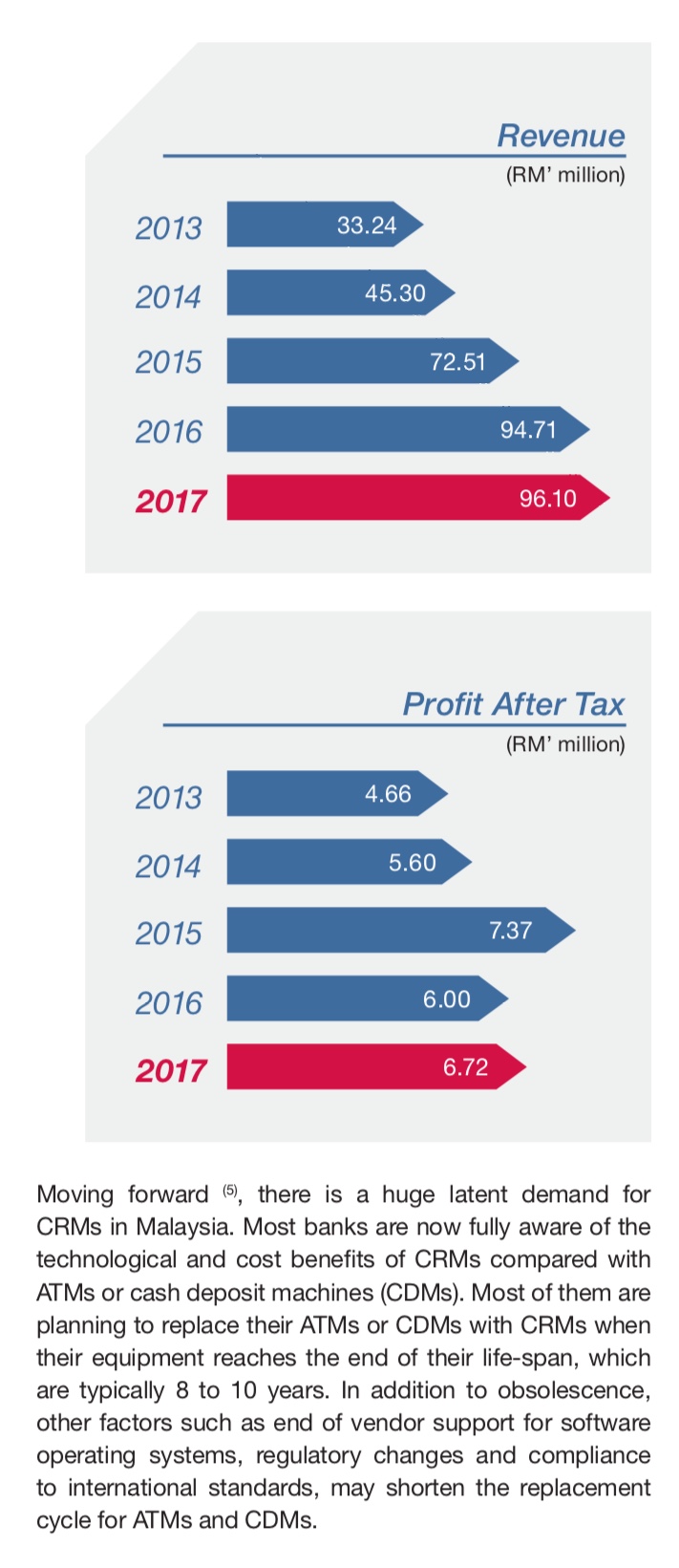Warning: This is a very long “Management Discussion & Analysis” but well worth the time. Great management is rare.
Rare indeed.
Management
is great. Just read the management analysis you know d. Alot of what
you need to know is actually in there, which is rare.

The march towards a cashless society, it seems, is unstoppable.
Virtual payments are fast displacing
cash. Fewer Nordic banks are using cash in their branches. India
recently scrapped 86 percent of its banknotes. South Korea plans to stop
minting coins by 2020. Young people especially, as well as the better
off and better educated, are increasingly at ease in making payments via
cards or mobile phones.
Perhaps the most famous example is that
of beggars in China’s big cities holding up signs with quick response
(QR) codes to collect alms. With loose change becoming a rarity,
charitable passers-by can make donations with their mobile phones
through Alipay or WeChat Pay.
But wait!
In other advanced economies, including Austria, Germany, Japan, Singapore and Switzerland, cash
is still king and shows no sign of abdicating. Globally, 85 percent of
all payments are still made in cash. “The cashless society, as appealing
as it may sound, is probably just as elusive as the much vaunted
paperless office”, according to Yves Mersch, a member of the European Central Bank’s executive board.
In tech-savvy Singapore, where almost
everyone has a mobile phone, nine out of 10 people, still prefer to pay
for everyday transactions the old-fashioned way – with cash. According
to interviews conducted by Bloomberg in September 2017, some of the
reasons why Singaporeans prefer cash are because it is more convenient
than swiping a bank card or in case when they can use digital devices,
machines sometimes break down and cannot process a payment.
In Japan, cash in circulation as a
percentage of GDP increased to 20 percent in 2017 from 13.5 percent in
2000 and in the United States, it gained to 8.1 percent from 6.0
percent. In the Eurozone, it rose to 10.7 percent from 5.1 percent in
2002.
Similarly in Malaysia, most people have a
relatively high dependence on cash for payment transactions. Last year,
cash in circulation (CIC) grew 11.5 percent year on year to RM85.46
billion. Meanwhile, CIC per GDP, a measure of a country’s reliance on
cash for transactions, expanded from 6.62 percent to 6.95 percent.
One of main reasons why cash remains
hugely popular is because cash is the only legal tender in every country
in the world, with the exception of Sweden. Cash is accepted
practicably by all traders, whereas there is no obligation to accept
electronic payments. As interest rates fall – and even go negative in
some places – cash is increasingly used as a store of value. Cash is the
only payment instrument that guarantees the user’s privacy and
anonymity, while all electronic transactions are traceable.
In OpenSys, we believe that the
migration of cash to digital payments will be a gradual process – an
evolution rather than a revolution. We also believe that cash, cards and
mobile payments will continue to coexist for many years to come
although we will see more and more micro payments being made by mobile
phones.
Based on our big data of approximately
500 bill payment kiosks deployed at the branches of six major telcos and
utility companies nationwide over the last 18 months, we noticed that cash booked over 65 percent or 11.0 million of the total number of payment transactions worth RM1.86 billion.
In contrast, credit and debit cards managed 21 percent or 3.7 million
transactions worth RM1.24 billion, while cheques recorded 14 percent or
2.3 million transactions worth RM13.43 billion. It is pertinent to note
that payment by cheques are mostly made by corporate customers hence the
absolute amount collected via cheques significantly dwarfed that of
cash or credit and debit cards.
Due to the complementary relationship
between cash and digital payments, the ubiquitous automated teller
machine (ATM) – which celebrated its golden 50th anniversary last year –
is still ranked as the No. 1 self-service channel and interactive
touchpoint with a bank, even among millennials and smartphone users.
From its inaugural installation at Barclays Bank in North London in June
1967, the ATM can now be found everywhere – from the most modern cities
to the loneliest outposts, including a mountaintop in the Himalayas.

As the number of ATMs increase, they
have also stepped up in sophistication to keep up with modern times.
Today’s ATMs are a far cry from that first installed ATM at Barclays
Bank. In addition to dispensing cash, today’s advanced machines can
accept cash and cheques; issue prepaid cards, stamps and lottery
tickets; grant loans and take payments of almost any kind; calculate and
convert one nation’s currency into another; remit money to a relative
halfway around the world; and most impressively, perform these functions
with better than 99 percent reliability.
In the foreseeable future, ATMs will
continue to evolve and remain relevant by adopting mobile technologies
to cater to millenials and Gen Z. There are already ATMs today that
allow customers to perform cardless ATM withdrawals using their mobile
phones. Not long from now, customers will sign into ATMs using their
fingerprints, pictures of eyes or faces, or voice recognition that are
stored on their mobile phones, which will then transmit a code to the
ATMs to do the necessary banking transactions.
It would not be inaccurate to consider
the ATM as the original “Fintech” disruptor because before it came
along, the banks were very traditional and dependent on a lot of human
resource to operate. The ATM basically transformed the
“brick-and-mortar” bank branch by automating cash withdrawals so that
human resources can be redeployed more efficiently to assist and educate
customers on the banks’ products and services.
While the ATM provides many upsides to
banks as well as their customers, the downside is that it is expensive
to set up and operate an ATM infrastructure. In addition to high capital
expenditure in hardware, software and network, the cost of cash
represents the largest single segment of operating expenses for ATMs.

Cash Recycling Machines (CRM)
To mitigate the high cost of cash, the
technology trend in recent years is to merge the separate functions of
cash- dispensing or cash-deposit into dual-function machines called cash
recycling machines (CRM). CRMs can accept cash from depositors and
dispense them to withdrawers so that the cash is essentially “recycled” –
resulting in lower cost of ownership in the area of unused cash float,
cash maintenance, cash handling and space rental. Besides savings of
25-30 percent in capital expenditure and operational cost, CRMs also
provide better service levels to the banks’ customers because they have
higher uptimes due to the automatic replenishment of cash in the
machines.
OpenSys technology partner in the CRM
market is OKI Electric Japan. OKI invented and pioneered the use of cash
recycling technology more than thirty years’ ago in 1982. Due to its
first mover advantage, OKI is currently one of the leading suppliers of
CRMs in Japan, China, India, Indonesia, Russia, South Korea, Taiwan and
Brazil.

Besides our CRM success, OpenSys provides
business process outsourcing (BPO) for bill payment kiosks to utility,
insurance and telecommunication companies in Malaysia. Our bill payment
kiosks allow customers to use cash, cheques, credit or debit cards to
pay for bills, reload prepaid cards and renew insurance policies.
OpenSys is also the leading supplier of
cheque-deposit machines and image-based cheque processing systems in
Malaysia. Our image-based cheque processing system uses cheque scanners
and software applications to capture cheque images and data at bank
branches and send them to the central bank for cheque clearing and
settlement. This paperless process saves the banking industry hundreds
of millions of ringgit per year.
Business models
OpenSys has four business revenue models,
namely (i) outright sales, (ii) software services, (iii) outsourcing
services and (iv) maintenance services. In outright sales, our CRMs and
cheque deposit machines are sold directly to the financial institutions.
In software services, we provide software development services to our
customers when they need modification to their application software due
to changes in their business or regulatory requirements. In outsourcing
services, we provide bill payment kiosks to utility, insurance and
telecommunication companies over a contract period of 3-5 years. The
customers pay a rental for the machines plus a click charge for each
transaction.
In maintenance services, the banks pay us
an annual maintenance fee of 10-12 percent based on the selling price
of the machines that we sold to them. In return, we service and repair
the machines to ensure high availability and optimum uptime. It is
important to note that all our customers are blue chip companies. Due to
the size of these companies, the collection risk for our trade
receivables is very low.
For the financial year ended 31 December
2017, our revenue marginally increased 1.5 percent to RM96.10 million
from a corresponding period in 2016 largely due to robust sales of CRMs
and more transaction volume from our outsourcing business. Meanwhile,
our profit after tax rose 11.8 percent to RM6.72 million as compared to
the year before.


Our outsourcing business in providing
bill payment kiosks to utility, insurance and telecommunication
companies continues to remain strong. Not unlike banks, these
institutions are transforming their branches to be leaner, friendlier
and more efficient by pushing mundane tasks to self-service kiosks. In
doing so, they can free up their valuable human resources to perform
more sales and marketing related activities with their customers. The
companies that are currently using our bill payment kiosks are
progressively installing more machines as time progresses.

Our Fintech strategy is to work closely
with financial institutions to “disrupt” themselves before they get
disrupted and to navigate the dreaded “tipping point” of business
cycles. It is our belief that despite the scaremongering, Fintech would
eventually be just another product(s) that will be offered by your
favourite bank that leverages modern technology. An Uber-like or
Airbnb-like disruption by startup companies is unlikely to happen
because the banking industry is ultimately based on trust, and requires
regulatory oversight to protect the consumer.
Our continued commitment to new product
development allows us to be more responsive to changes in technology,
industry standards and customer expectations while mitigating any
effects of product obsolescence. The carrying book value of our
development expenditure for the year ended 31 December 2017 is
RM0.18million.
We currently own one floor of office
property at Pinnacle PJ and another three-storey shop office property at
Putra Heights with an estimated value of RM10.0 million and RM3.0
million respectively. The property at Pinnacle PJ is used as our
corporate headquarters whereas the property at Putra Heights is mainly
used for the assembly of our cheque deposit machines and CRMs.
With regard to creating value for our
esteemed shareholders, we have consistently paid semi-annual dividends
to our shareholders for the last 7.5 years since July 2010. In October
2015, we gave a bonus issue of 74.47 million new ordinary shares on the
basis of one bonus share for every three existing OpenSys shares to our
shareholders. The next dividend payment is on 18 April 2018. As our
cashflow is particularly healthy, we are confident that our dividend
plan is sustainable subject to unforeseen circumstances that might be
beyond our control.
The Board of Directors would like take
this opportunity to extend our gratitude and appreciation to our
shareholders, customers, suppliers and business partners for the
invaluable support that you give to OpenSys.
We would also like to thank each and
every member of our management and staff for their dedication and
commitment to grow with our Company, without which our success would not
be possible.
Source
Annual report 2017

https://klse.i3investor.com/blogs/Amazinggrowth/198168.jsp
